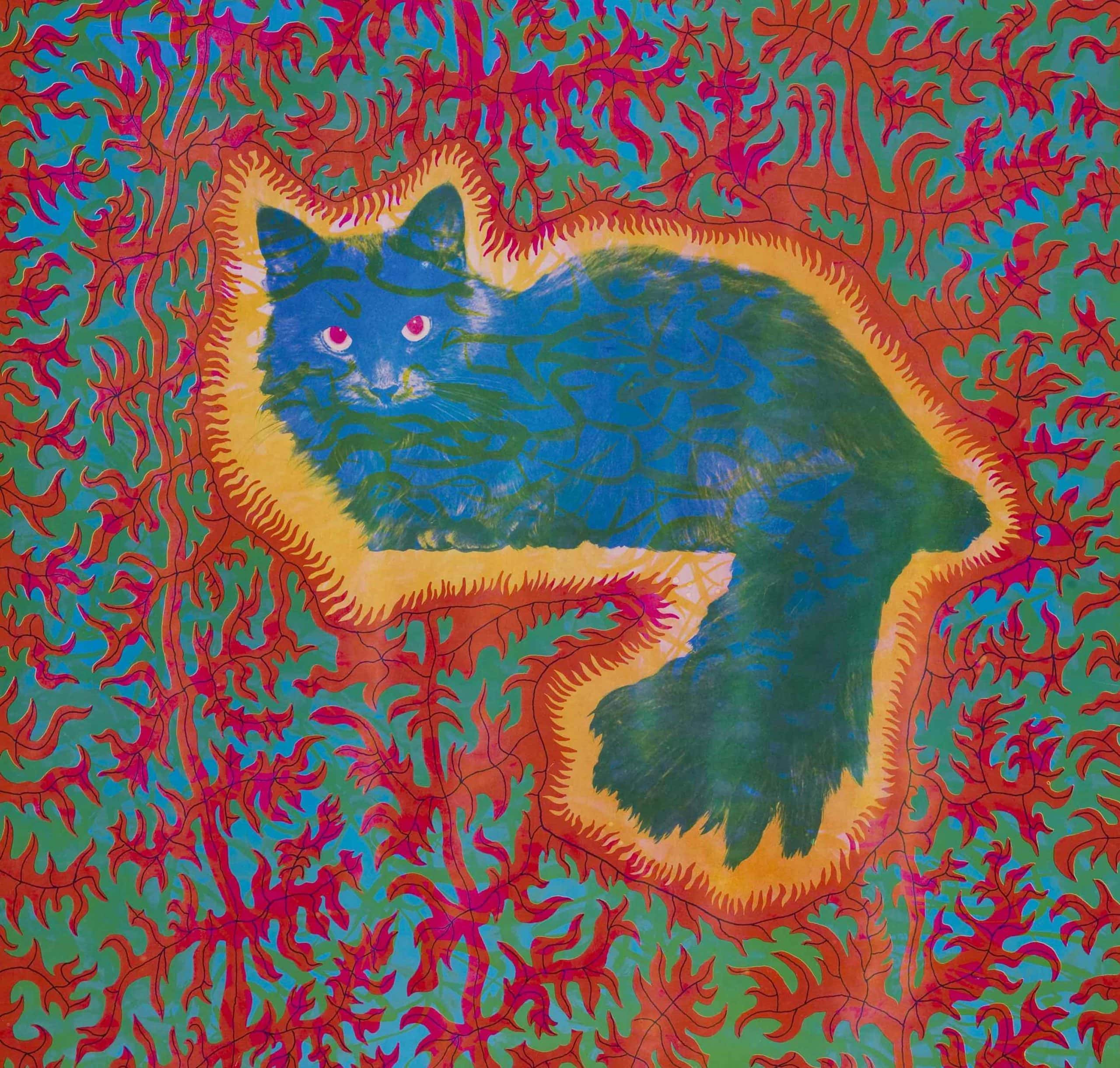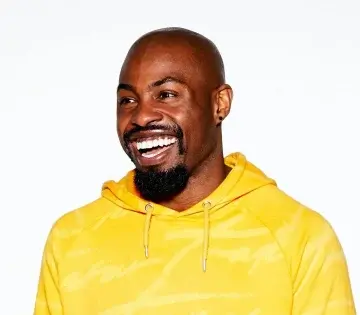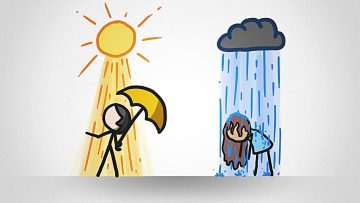
Think Lewis Carroll, think Alice In Wonderland; think Alice in Wonderland, think the Disney schmaltz of blue dresses, pink Cheshire Cats and caterpillars with hookahs (that’s hookahs, not hookers). Or, worse, think Tim Burton in CGI technicolour, mad Johnny Depp romping around in pinstripes, and Helena Bonham Carter screeching as a wiggy Queen of Hearts.
However you look at it, Alice in Wonderland has been dealt a shitty hand in the twentieth and twenty-first centuries. At best, it’s children’s fantasy; at worst it’s Disney and Burton in their putrid, past-prime stages. It’s saccharine, garish, and all-too familiar; the stuff of nightmares rather than dreams. So why are we still talking about it?

Original drawing for Alice in Wonderland of the White Rabbit, Ralph Steadman, 1967
More than a bookend
Last month, the V&A launched its flagship exhibition, Alice: Curiouser and Curiouser, charting the influence of Carroll’s dreamy story across art, design, music and performance. Featuring immersive VR installations, full-scale stage-sets, a Jefferson Airplane soundtrack, and ephemera from the Carroll archive, the exhibit has been met with rave reviews across the board; with even the usually-jaded Jonathan Jones giving it five stars, praising it as “a wonderful tumble down the rabbit hole.”
Clearly, there’s a lot to be said about the impact of Alice in Wonderland, but in focusing on the visual cultures that it’s inspired, exhibitions like this risk downplaying the novel’s greatest achievement: it’s vale-cracking effect on literature, it’s paving-of-the-way for the modernist movement that would blossom in the UK, a little more than fifty years after its publication.

Cheshire Cat, Joseph McHugh, published by East Totem West. USA, 1967
To give him his dues, Jones picks up on this literary lineage, bookending his Guardian review with references to Joyce, Kafka, and Beckett. But Carroll’s significance in the story of literature is far more than a bookend; it marks the end of the book as we know it.
Because, to restate the question of why Alice lingers in popular culture, the answer lies in language, not image; it lies, that is, in Carroll’s exquisite ability to push English to the very limit of logic, to test the boundaries of sense and, in so doing, to craft a world through words.
For all the adaptations, dramatisations, and artist-interpretations, Alice in Wonderland, and it’s sequel Through the Looking Glass, remind us that sometimes, there really is no substitute for language itself.
Array‘Must a name mean something?’
Lewis Carroll was no literary scholar. In fact, he was a mathematician, with a prestigious post at Oxford University and an interest in geometry, linear and matrix algebra, and mathematical logic, about which he penned almost a dozen influential books under his real name, Charles Dodgson (Carroll was his nom de plume for fiction writing). If such a background seems surprising for one of the English language’s greatest wordsmiths, take a look at one memorable episode from Alice Through the Looking Glass:
‘Don’t stand chattering to yourself like that,’ Humpty Dumpty said, looking at her for the first time, ‘but tell me your name and your business.’
‘My name is Alice, but —’
‘It’s a stupid name enough!’ Humpty Dumpty interrupted impatiently. ‘What does it mean?’
‘Must a name mean something?’ Alice asked doubtfully.
‘Of course it must,’ Humpty Dumpty said with a short laugh: ‘my name means the shape I am — and a good handsome shape it is, too. With a name like yours, you might be any shape, almost.’
Nearly fifty years before Ferdinand de Saussure would write his General Course in Linguistics, the first fully-fledged theory of semiotics, Carroll was exploring the relationship between sign, signifier, and signified – the relationship, that is, between a word and what it refers to in the real world – through the nursery-rhyme figure of Humpty Dumpty. But let’s pull back a moment, because:
‘[…] this conversation is going on a little too fast: let’s go back to the last remark but one.’
‘I’m afraid I can’t quite remember it,’ Alice said, very politely.
‘In that case we start afresh,’ said Humpty Dumpty, ‘and it’s my turn to choose a subject —’ (‘He talks about it just as if it was a game!’ thought Alice.) ‘So here’s a question for you. How old did you say you were?’
Alice made a short calculation, and said ‘Seven years and six months.’
‘Wrong!’ Humpty Dumpty exclaimed triumphantly. ‘You never said a word like it!’
‘I thought you meant “How old are you?”‘ Alice explained.
‘If I’d meant that, I’d have said it,’ said Humpty Dumpty.
Carroll’s Humpty is a linguistic pedant, and in holding to the logic of language so inexorably, he reveals the absurdity of reason.
In other words, Carroll understands that language is upheld by a series of logical structures (syntax, grammar, and so on), but that the ordinary flows of speech often sidestep that logic; that we don’t say exactly what we mean, precisely because language isn’t maths – but Carroll can only expose that disjunct because of his mathematical mind, in just the same way that the mathematical philosopher Ludwig Wittgenstein would also do, some 50 years later.

‘Old Dadgerson’s dodges’
Throughout Through the Looking Glass, Alice looks for help in decoding a poem. You’ve probably read it before, at school, perhaps, or in an anthology of children’s poems. But, before you consign ‘Jabberwocky’ to the scrapheap of classroom nightmares, just take a quick look again:
”Twas brillig, and the slithy toves
Did gyre and gimble in the wabe:
All mimsy were the borogoves,
And the mome raths outgrabe.’
I count eleven made-up words in the opening stanza alone; and yet, somehow, almost impossibly, the verse appears to make sense. We’re convinced by the sounds of the words, by the way they look (surely I’ve read ‘outgrabe’ somewhere before?), and the way they scan with the poem’s iambic tetrameter rhythm. But what does any of it actually mean? Let’s have a look at Humpty’s gloss:
“Brillig” means four o’clock in the afternoon — the time when you begin broiling things for dinner.’
‘That’ll do very well,’ said Alice: ‘and “slithy”?’
‘Well, “slithy” means “lithe and slimy”. “Lithe” is the same as “active”. You see it’s like a portmanteau — there are two meanings packed up into one word.’
‘I see it now,’ Alice remarked thoughtfully: ‘and what are “toves”?’
‘Well, “toves” are something like badgers — they’re something like lizards — and they’re something like corkscrews.’
‘They must be very curious-looking creatures.’
‘They are that,’ said Humpty Dumpty; ‘also they make their nests under sun-dials — also they live on cheese.’
‘And what’s to “gyre” and to “gimble”?’
‘To “gyre” is to go round and round like a gyroscope. To “gimble” is to make holes like a gimlet.’
All through the book, a cast of characters will offer Alice a variety of readings of the poem; just as, in the real world, a single verse will elicit a different interpretation from every reader. It’s a reminder that words aren’t fixed. That even though we attach clear meanings to them, words are sort of, well, “slithy”; they “gyre” and “gimble” all over the place – which is why poetry is so full of possibility.

Alice talking to the Cheshire Cat, 1865. Illustration Sir John Tenniel
It’s Humpty’s gloss of the text that best captures Carroll’s play with the pun and the portmanteau, with the meaning, sound, and texture of words. These nonsense hybrids are so much more than just fun sounds for kids: they throw everything into question.
They force us to ask: What does govern the relationship between a word and its meaning? Because, in the midst of all this wordplay, what Carroll is really doing is troubling the seam between poetry and prose, and letting words loose to behave in naughty, anarchic, and unexpected ways.
Which is precisely what the modernist writer James Joyce would do, half a century later. Like Carroll, Joyce everywhere revels in the pure pleasure of wordplay, but it’s in his final, and most difficult, work, Finnegan’s Wake, that the influence of the earlier writer can be felt most strongly:
To tell how your mead of, mard, is made of. All old Dadgerson’s dodges one conning one’s copying and that’s what wonderland’s wanderlad’ll flaunt to the fair. A trancedone boyscript with tittivits by. Ahem.
Old Dadgerson, of course, is Charles Dodgson (aka Lewis Carroll), and Joyce himself is “wonderland’s wanderlad,” flaunting his “copy” of mishmash words. Like Carroll, Joyce’s puns and portmanteaus are both lyrical and comical (“Lord help you Maria, full of grease, the load is with me!”), erasing the line between poetry and prose: a modernist revolution that began in a work of Victorian children’s fiction.

A Mad Tea Party, Salvador Dali, 1969, Dallas Museum of Art
‘Two little fat men’
If Joyce was the inheritor of Carroll’s pleasurable wordplay, then Franz Kafka was surely the descendant of his labyrinthine dreaminess. Kafka is often treated as if he sprang from nowhere, without precedent or equal, and it’s largely true; there aren’t many writers, either before or since, who rival Kafka in capturing the quality of a dream – except, that is, for Carroll. Compare this moment in Through the Looking Glass:
So she wandered on, talking to herself as she went, till, on turning a sharp corner, she came upon two little fat men, so suddenly that she could not help starting back, but in another moment she recovered herself, feeling sure that they must be Tweedledum and Tweedledee. They were standing under a tree, each with an arm around the other’s neck […] They stood so still that she quite forgot that they were alive.
with this scene from Kafka’s unfinished novel, The Castle:
Coming from the direction of the castle were two young men of medium height, both extremely slim, dressed in tight-fitting clothes, facially very similar too, with dark-brown complexions, against which goatee beards nevertheless stood out with especial blackness. They were moving astonishingly fast, given the road conditions, swinging their slim legs rhythmically.
Two twins, dressed in identical outfits – two of them fat, the others thin, two standing in stillness, the others marching at rhythmical speed. In both, the prose remains matter-of-fact, but the details are strange, absurd even; and the sober description only heightens the comedy.

Alice (Roma Beaumont) with Humpty Dumpty (Julian Somers) on the wall, 1944. (Photo: Kurt Hutton)
In both, the protagonist (Alice; K.), finds themselves in a strange place, without explanation, walking relentlessly in search of answers to questions that haven’t even been asked yet. As they move through their respective novels, new settings unfold suddenly and without announcement, as if the walls of one stage set were silently wheeled away and replaced with another, stranger, tableau.
Carroll’s foray into the dream, the subconscious, and the surreal, anticipates not only Kafka, but Andre Breton, Gertrude Stein, Virginia Woolf, and other modernist writers whose work was marked out by a post-Freudian deep-dive in the dreamy mists of the mind. And as for Freud himself, he wasn’t even out of his oedipal phase when Carroll was plunging down the rabbit hole (when Alice in Wonderland was published Freud was only 9 years old).

Charles Lutwidge Dodgson, or Lewis Carroll. (Photo: Oscar Gustav Rejlander)
‘I shall never, never forget!’
So much of Carroll’s mastery stems from an ability to fuse: to fuse the logical with the illogical; the literary with the mathematical; poetry with prose; the adult world with the child’s – though this last point raises a problem: the fact, as many of Carroll’s biographers have noted, of his obsession with prepubescent girls, who he photographed and illustrated (often naked or scantily clad), wrote about, and spent excessive periods of time with. And it’s a problem that’s writ large on the Alice stories – there’s even speculation that Carroll wanted to marry 11-year old Alice Liddell, the novel’s muse, when he was 31.
Separating art from an artist remains a constant and contentious issue. One can’t – and shouldn’t try to – ignore or deny the facts of Carroll’s biography (especially when they weigh so heavily on the text); but, at the same time, one can’t overlook the genius of Carroll’s writing. So don’t forget the problems – for better or for worse, they’re tied to the writing.
But do, please, forget those sickly Disney and Burton travesties – and remember, instead, a writer far ahead of his time, a master of the pun, of wordplay, of dream fiction, surrealism, and the subconscious, and a man who set the stage for a revolution in language.


